Roof Replacement Options: Roof Overlay vs. Tear-Off: Pros, Cons, Costs

If you're considering replacing your roof, you're probably asking: Should I save money with an overlay, or invest in a full tear-off?
At first glance, a roof overlay may seem like the easier, more affordable option. In limited situations, it can be, but our work with homeowners across Naperville and the surrounding suburbs shows that this "quick fix" often hides bigger problems underneath.
At Happy Roofing, we believe homeowners deserve clear, honest answers before making a decision this important. That's why this article covers the key differences between overlays and tear-offs. We'll go over the pros and cons, average costs, and key factors to consider before making the decision for your home.
Table of Contents
- The Difference Between a Roof Overlay and a Tear-Off
- Pros and Cons of a Roof Overlay
- Pros and Cons of a Roof Tear-Off
- Which Option is Better for Your Home, a Roof Overlay or a Tear-Off?
- Roof Overlay vs. Tear-Off Cost Comparison
- Other Factors That Drive Roofing Costs Up or Down
What's the Difference Between a Roof Overlay and a Tear-Off?
A roof overlay involves adding a new layer of shingles directly over your old roof, without replacing any existing components or materials. A roof tear-off includes removing the existing shingles (along with underlayment, flashing, and other worn roof components) before installing a brand-new roofing system.
While the definition sounds straightforward, the differences between these two approaches affect cost, lifespan, and even your home's structural integrity.
Here are the biggest differences between a roof overlay and a tear-off:
- Overlay (also called re-roofing): This approach directly installs a new layer of shingles on top of the old ones. Because there's less labor and no disposal fees, overlays are cheaper and faster. However, they trap heat, add weight to your roof, and cover up any potential issues the existing roof may have. What looks like a quick, budget-friendly fix often leads to shorter roof life, potential warranty issues, and costly repairs if hidden problems go unchecked.
- Tear-off: A tear-off removes every component, down to the roof decking, before new underlayment and shingles are installed. This process takes longer and costs more upfront because it involves additional labor, disposal, and replacement materials. The benefit of a tear-off is that it exposes any damaged or rotted materials, allows fresh underlayment and flashing to be installed, and gives the roof a stronger, longer-lasting foundation. This gives your roof its full lifespan potential, keeps warranties intact, and provides peace of mind knowing no hidden damage is left behind.
For homeowners in the greater Naperville area, this choice matters because our weather (heavy snow, freeze-thaw cycles, and hot summers) puts added stress on roofs, making quick fixes like overlays more prone to problems. While Naperville's building code doesn't clearly state a maximum number of roof layers for most asphalt shingle installations, permit guidelines and manufacturer warranties often favor tear-offs.
What Are the Pros and Cons of a Roof Overlay?
A roof overlay can look attractive on paper: it's cheaper, faster, and far less disruptive than a full tear-off. But those short-term conveniences come with trade-offs, like long-term cost, that most homeowners need to weigh carefully.
While overlays can save money now, they almost always cost more in the long run.
Pros of a Roof Overlay
- Lower upfront cost: Roof overlays require no removal of existing materials, meaning less disposal and labor costs. Additionally, since overlays don't expose any roof decking or other roofing components, fewer materials are needed to complete the project. This can be appealing for homeowners planning to sell soon, where a lower investment may still improve curb appeal.
- Faster installation: Skipping the tear-off process means crews can finish relatively quickly, usually within a day. This minimizes time spent on your property. In some cases, this speed can be useful for homeowners who need a roof in place very quickly, like before listing a home.
- Less mess and disruption: Retaining the old shingles or underlayment to remove means fewer dumpsters, less debris, and less noise during the project. This can be convenient for homeowners in tight neighborhoods or areas with limited access, where managing disposal logistics would be difficult and add to project costs.
Cons of a Roof Overlay
- May void manufacturer warranties: Most shingle manufacturers will not honor warranties covering roof overlays because the installation doesn't meet their standards for proper performance. This leaves homeowners unprotected if problems arise.
- Shorter lifespan: The extra layer of shingles can trap heat, which speeds up shingle wear. Overlays typically last 10–15 years compared to the 20–30+ years that's expected with a roof tear-off.
- Can hide underlying issues: A long-lasting roof depends on more than the shingles alone. The roof deck serves as the solid foundation for your shingles, while flashing helps keep moisture from entering your home. Rotted decking, damaged flashing, or other potential issues remain covered up, allowing them to worsen over time and cause expensive problems. The extra layer of shingles can also make repairs more difficult.
- Higher long-term cost: If problems emerge later, you'll most likely need to pay for a full tear-off anyway to correct the damage effectively. The added time and expense of removing multiple layers of shingles rather than one can negate any cost savings that were made by opting for the overlay to begin with, depending on your situation.
This photo from one of our past roof replacement projects shows how all of the shingles are removed from the existing roof in order to replace the underlying components:

What Are the Pros and Cons of a Roof Tear-Off?
A roof tear-off is the safest and most thorough way to replace your roof because it removes everything down to the decking before installing new shingles. It costs more and takes longer than an overlay, and it gives your home an entirely new roofing system, exposes hidden issues, and provides the longest-lasting results.
Pros of a Roof Tear-Off
- Identifies hidden damage: Removing the old shingles reveals problems like rotted decking, loose nails, or worn flashing that would remain hidden during an overlay. Fixing these issues early prevents bigger, costlier repairs later and ensures your roof lasts as long as it should. This is a major benefit for those who are planning to keep their home long-term.
- Longer lifespan and better warranty eligibility: A new roof installed after a tear-off can last 20–30 years or more with proper installation. Because this method meets manufacturer standards, it typically qualifies for full shingle warranties as long as the specific manufacturer's other criteria are met (some brands require you to have a full roofing system approved by them to qualify).
- Improves long-term resale value: Homebuyers and inspectors see a roof tear-off as a sign of quality and care. It reassures future buyers that the roof is truly new, not just buying time for the next repair or replacement. This could potentially increase your home's resale value if you keep documentation, and at the very least, could help during negotiations if you plan on selling your home.
Cons of a Roof Tear-Off
- Higher initial cost: Because a tear-off requires removing the old shingles, replacing underlayment, and disposing of debris, it's more expensive upfront than an overlay. Homeowners should budget for the added labor and material costs when planning a full replacement, but the added cost doesn't always make sense for every situation, like if you plan to sell the home immediately or it's scheduled for demolition within the next few years.
- More labor-intensive: Stripping away existing layers, correcting ventilation, replacing underlayment and flashing, and making decking repairs takes more time than laying shingles over what's already there. Tear-offs can typically take 2–3 days, compared to 1–2 for overlays, depending on the roof's size and complexity. Homeowners under strict time constraints may not benefit from a roof tear-off.
- Temporary disruption: A tear-off project generates more debris and noise than an overlay, and often requires a dumpster on-site. Homeowners should expect some impact on parking, yard access, and their daily routines until the job is complete.
Is a Roof Overlay or Tear-Off Better for Your Home?
A roof overlay might be an option if your existing roof is in good condition and local building codes allow it. But for most homeowners, a full tear-off is the safer long-term investment.
Here's what determines if an overlay is right for your home:
- Roof condition: Overlays only work if the current shingles are lying flat and the decking underneath is solid. Curling, warped, or soft spots mean a tear-off is required. If you install new shingles over worn materials like these, you're essentially covering up problems that will only get worse. In Chicagoland's freeze-thaw climate, those hidden weak points can turn into leaks or structural issues much faster than expected.
- Local building codes: Naperville, like other jurisdictions, follows the 2018 International Residential Code (IRC), which doesn't clearly set a cap on the number of shingle layers allowed. While there isn't specific language specifying this in the IRC, some Illinois municipalities limit you to one additional layer of shingles, like in Lombard. It's important that your roofing contractor is knowledgeable about local codes in your area.
- Weight limits: A single overlay of asphalt shingles adds 2–3 pounds per square foot. On a 2,000-square-foot roof, that's an extra 4,000–6,000 pounds sitting on your home. That added stress can lead to sagging, structural strain, or even long-term safety issues. This, combined with Midwest snow and ice, can push your roof system beyond its limits, creating risks that aren't worth the short-term savings.
- Ventilation and heat: Overlays trap more heat in your attic, accelerating shingle wear and shortening the roof's lifespan. Shingles don't insulate like walls or attic insulation. Instead of keeping heat out, the extra layer absorbs and holds more of it, baking them from above and below. This trapped heat accelerates deterioration and cuts the roof's lifespan significantly.
Here's a simple comparison to help you understand which option may be the better fit for your home:
| If… | Then… |
|---|---|
| If your current shingles are flat, the decking is solid, and local codes allow another layer of shingles | An overlay might be possible as a short-term, lower-cost solution. |
| If you see curling shingles, soft decking, or existing leaks | A tear-off is necessary to fix hidden problems and ensure the new roof lasts. |
| If your home is older, built with lighter trusses, or regularly bears heavy snow loads | A tear-off is safer, since overlays add thousands of pounds of extra weight. |
| If you're planning to sell your home soon and just need a cosmetic improvement | An overlay may improve curb appeal at a lower cost, but a tear-off could strengthen negotiations and the selling price. |
| If you plan to stay in your home long-term or want the strongest warranty protection | A tear-off is the best investment, offering a longer lifespan and full warranty eligibility. |
How Much Does a Roof Overlay Cost Compared to a Tear-Off?
In the Naperville area, a roof overlay typically costs less upfront, averaging $4–$6 per square foot, while a full tear-off usually ranges $6–$9 per square foot. The difference comes from the added labor, disposal fees, and material replacement required for a tear-off.
Example Roof Cost for a 2,000 Square-Foot Roof
Overlay: $8,000 – $12,000
Tear-Off: $12,000 – $18,000
While a roof overlay may save $4,000–$6,000 upfront, it typically lasts only half as long as a tear-off, meaning homeowners often pay more in the long run if they plan on staying in the home.
What Drives Roofing Costs Up or Down?
When it comes to roof replacement, there are other variables beyond whether you choose an overlay or a tear-off. Roof size, slope, materials, ventilation performance, and the condition of the roof deck can all influence the final cost of your roofing project.
If you'd like to dive deeper into the key factors that drive roofing costs, check out our full guide: What Impacts the Cost of a Roof Replacement? Top Pricing Factors. It breaks down everything you should know before agreeing to any estimates, so you're not blindsided by any cost variables.
Still unsure whether your roof could benefit more from a tear-off or an overlay? We offer non-commitment inspections meant to evaluate your entire roofing system. While we don't offer roof overlays, our goal is to provide the clarity you need to help you make an informed decision on your next roofing project, whether you decide to partner with us or not.
The Author: Pedro Toledano
Happy Roofing is a trusted roofing company dedicated to providing top-quality roofing services to residential and commercial clients. With years of experience, they specialize in roof installations, repairs, and maintenance, ensuring durability and customer satisfaction. The team is known for their professional approach, timely service, and attention to detail. Happy Roofing prides itself on using high-quality materials and offering competitive pricing. Follow their Facebook page for updates on projects, customer testimonials, and tips on maintaining your roof in excellent condition.





